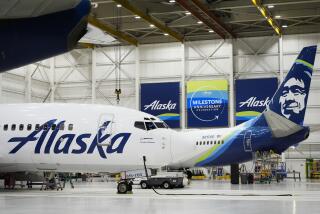Misaligned panel blamed for hole in Southwest jet’s fuselage
- Share via
This post has been updated. See below for details.
A hole that opened up in the fuselage of a Southwest Airlines plane in 2011 was probably the result of a misaligned panel installed during manufacturing.
That was the finding in a report released by the National Transportation Safety Board on Flight 812, which made an emergency landing over Yuma, Ariz., on April 1, 2011.
The tear that opened up on the Boeing 737-300 caused the cabin to quickly depressurize, forcing the pilots to land at Yuma International Airport. A crew member and an off-duty employee suffered minor injuries in the incident.
Once on the ground, officials found a layer of the fuselage’s outer skin had torn lose, making an opening eight inches wide by 60 inches long, the report said.
The NTSB report said the agency could not determine if the error in installing the fuselage section was done at Boeing’s facilities in Wichita, Kan. or Renton, Wash.
“Evidence indicates that during drilling of the S-4L lap joint, the crown skin panel and the upper left fuselage panel were misaligned, so most of the lower rivet row holes were misdrilled,” the report said. “Many of the installed rivets did not completely fill the holes in the lower skin panel, which significantly reduced the fatigue life of the panel.”
Following the incident, Boeing and the Federal Aviation Administration called for added inspections of the fuselage lap joints on many 737 planes.
[Updated, 2:10 p.m. Sept. 30: In response to the NTSB report, Southwest Airlines released the following statement: “While the NTSB has identified a manufacturer issue, we have full confidence in Boeing’s ability to ensure our aircraft remain safe.”]
ALSO:
Super-cheap airline may be ready for takeoff
Proposed airline merger could prevent fare increases
Bill would require a second cockpit door on commercial aircraft
More to Read
Inside the business of entertainment
The Wide Shot brings you news, analysis and insights on everything from streaming wars to production — and what it all means for the future.
You may occasionally receive promotional content from the Los Angeles Times.











